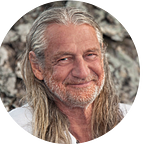Why People of Faith Need Yoga | Mark Whitwell
It was Krishnamacharya’s scholarly view that a daily Yoga practice is required for any religious person if they are to realise the beautiful ideals of their faith. Whether it is the temple faithful of Hinduism and Buddhism or the world faiths of Islam, Christianity or Judaism and all their derivatives, or the many sincere faithful people of Sikhism, Jainism, Zoroastrianism, Ba’hai, and all the other rich articulations of faith, a genuine practical means for each individual to directly embrace the inherent radiance of their own condition is required.
Why?
Because without a means to viscerally feel into the present wonder, beauty, power, and divinity of our lives, to connect to the inherent Godliness of the body and of all tangible conditions, the usual religious life is limited to mere belief. God remains an abstraction who is ‘other,’ a future possibility that is not yet realised. Convinced that we are not yet arising in Truth, our mind ties itself in knots trying to find it.
As a result, a worldwide pathology of dissociation and despair is now the normal state of affairs — we have been indoctrinated into a search for Truth as if Truth is absent. We are not acknowledging one another as the wonder of the universe, nor are we giving that understanding to our children.
“Man’s heaven has created a hell out of this abundant paradise,”my friend U.G. Krishnamurti used to say.
The shift that is required for humanity is to move from the exoteric patterning of religious power structure to the esoteric practice of direct and personal participation in Reality as it actually is: the unity condition of the cosmos, the nurturing flow of love-bliss that is the body, the mind, and all tangible and intangible conditions arising. Religion becomes true and useful only when ideas of separation and hierarchy dissolve.
The means of making this transition is to embrace the spirit-breath. In the wisdom traditions of both east and west it is deeply acknowledged that breath and spirit are one and the same force. “As long as my breath is in me, the spirit of God is in my nostrils” — The Book of Job. Christ himself was well-known as a spirit-baptiser who turned people to the divine via their breath.
This is the function of asana and pranayama and it is central to the Yoga that Tirumalai Krishnamacharya rescued from obscurity in Tibet. Yoga is to imbibe and saturate the body with breath/spirit, and to link the mind to the inherent divinity of the body. The body is that which is prior to the presumption of separation, to thought, and all dissociative patterning that we may have accumulated in this lifetime and previous ones.
Specifically, Yoga is the union of opposites. The embrace of the natural polarities of Life: above/below, left/right, inhale/exhale, strength/receptivity, inner/outer, male/female, yin/yang, Shiva/Shakti. By participating in and merging the opposites in our own embodiment (via the breath) we become sensitive to our Heart — known in the traditions as the spiritual heart, the hridaya, and the heart on the right.
We all know the phrase: “The mind is a wonderful servant, but a terrible master.” And we can observe in our communities that when the mind is dissociated from its source and context it can literally go insane. But what is the mind a wonderful servant to? In the ancient culture of Veda it was inherently understood that the mind is a function of the Heart, that’s all. It’s there to say “I love you” and to witness the splendour of the cosmos in this brief life that we have been given.
Bhagavan Nityananda, one of the last known Siddha gurus of modern times himself said:
“The Heart is the hub of all sacred places. Go there and roam.”
What he means here is that the secrets of the universe, and the spiritual and religious truths that have been preserved in sacred text, are in you, as you.
In my life of teaching, I have seen countless people of faith become empowered by their Yoga practice. When they discover their breath, the ideals of sacred text come alive for them. The instruction of the Bhagavad Gita to be unprovoked by the content of one’s experience becomes a tangible possibility in daily life. The beautiful advice of Christ to “Love thy neighbour as thyself” becomes real.
The paradox here is that Yoga at once dissolves the thought-structures of fear, hierarchy, and separation that have defined exoteric religion for millennia — cults, priesthoods, and power structures of all kinds — whilst at the same time providing the practical means by which the beautiful ideals of exoteric religion are themselves realised.
This is why Krishnamacharya and his brilliant son Desikachar were fiercely committed to bringing Yoga through into the world. Sadly, real Yoga remains completely underrated within the religious traditions of humanity, as well as in the Yoga cults. Our job is to bring the understanding of real Yoga through to all people so they can relax into the present wonder of the given reality.
*Join my friends and I for live classes and conversations in the online heart of yoga studio. We are here to help you get the Yoga that is right for you.
